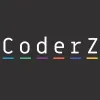Take a look inside 5 images
CoderZ
Pros: Complete curriculum, easy-to-follow step-by-step instructions; virtual robots don't require hardware or space.
Cons: Task-oriented missions limit creativity; weak connection between block- and text-based code.
Bottom Line: This coding curriculum has great scaffolding for students, but you'll need to find other ways for students to design and create.
CoderZ offers a very complete curriculum for programming virtual robots. For teachers without a lot of experience teaching coding or robotics, they can follow the curriculum step by step (45 hours' worth of lessons) to help students build skills in coding virtual robots. Students could work individually to complete each task or could be assigned to work in small groups. Even as an experienced teacher, however, you'll have to follow the tasks set up by CoderZ: There's no leeway to create brand-new challenges for students to complete.
Once students are comfortable programming with block-based code, you'll want to help them shift to text-based Java (the underlying code represented by their blocks). Since CoderZ doesn't have an explicit transition from block-based coding to Java, teachers will have to push students to experiment with the actual code, or else students won't ever use it.
CoderZ is a web-based platform where students code virtual 3D robots to complete missions. After joining their online class, students step through clearly delineated tasks to make a robot follow a particular path or move around obstacles. Students select different block-based code commands to control the robot's movement and interaction with elements on the screen. On the programming interface, students can switch from block-based code to Java. Students are also able to see data from the robot's sensors, add a trail to mark its path, control the robot manually, and download the program to use with an actual robot (like a Lego Mindstorm EV3).
Teachers are able to create classes and enroll students, as well as access the curriculum, solutions, extra challenges, and more. Teachers can also view statistics for classes and individuals.
CoderZ offers students the opportunity to code robots without the teacher or the school having to buy robotics kits or create a robotics lab. For students interested in using code to complete tasks, it's good. The curriculum is a clear progression of skills from basic (sequences of simple instructions) to more complex (involving loops, variables, and functions). Like a puzzle challenge, many students will find this very engaging; each level gives a feeling of accomplishment and growing skills. Students can get suggestions to help them work through the complexities of their code, or, in a worst-case scenario, get solutions. The graphics and interface are all very appealing to users.
Although Coderz is well-designed, there's not enough of a clear connection between block-based coding and text-based coding (in this case, Java). Though students can see the Java for any code they put together, there's no need to do so. This limits the applicability of what students do in CoderZ to the real world. For those who look at coding as a way of combining creativity, design, and computational thinking to build new things, CoderZ isn't the answer. It's not open-ended; tasks are defined and students move through different levels by completing them. There needs to be a lot more opportunity to create and design from scratch if we want students to see the potential of coding. Ultimately, CoderZ may be an ideal tool to use in a club for students with an interest in robotics, but you'll need to supplement with more creative tools.














